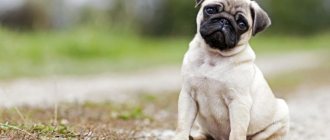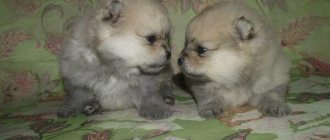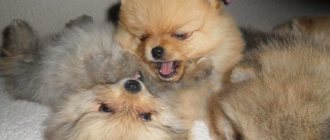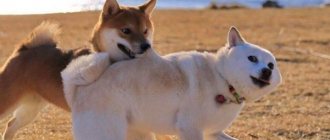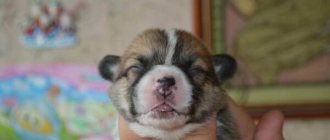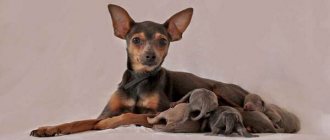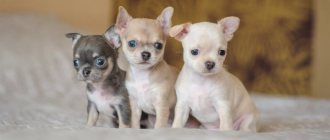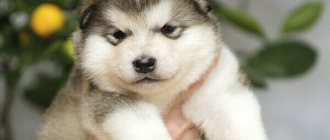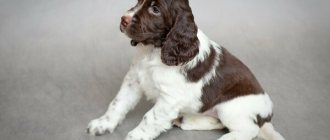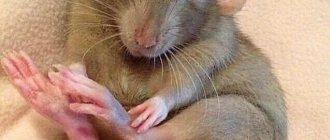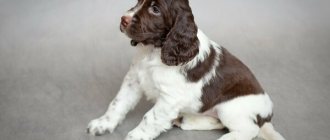Pug dogs are square, stocky dogs with a short muzzle.
Mentions of these animals are described in ancient Chinese manuscripts. The pug breed, like the Pekingese, undoubtedly comes from China, although they are also mentioned in the ancient Hindus.
These dogs were the favorites of the emperors of that era.
Their only purpose was to accompany the emperor. It is known that pugs had personal servants who carried them on special stretchers.
Since the establishment of trade routes between Europe and the Far East, about 400 years ago, pugs have gained popularity in Europe among both nobility and commoners.
There is a story about how a pug saved William of Orange by waking him up when the Dutch king’s camp was attacked by an enemy, and since then he has become the official dog of the House of Orange.
The pug was a favorite of Queen Victoria and Empress Josephine, wife of Napoleon.
Origin story
The breed is distinguished by the fact that in appearance their face resembles that of a monkey, with large, dark, wide-set eyes. For this reason, in England, pug dogs are called “Pug”, this is due to the humorous nickname of the cheerful monkeys.
The pug has been a ladies' dog since the 17th century, their charming ugliness complementing the beauty and sophistication of their owner..
Education and training
Training and education of a pug should begin from a very early age. They have a fairly high intelligence, but at the same time they are stubborn and capricious.
Therefore, it is worth showing patience and perseverance when training your pet. Under no circumstances should you shout or even hit a pug; in this case, he will withdraw and begin to do everything out of spite.
It is inappropriate to make a service dog out of such a small dog, so this issue must be approached wisely - a general obedience course will be quite enough. If you can’t handle it yourself, you can contact a specialist.
Return to content
a brief description of
Pugs are funny, inquisitive, friendly, self-loving, and the sounds made by these cuties (grunting, snoring, snorting) attract everyone's attention.
They are devoid of aggressiveness and are very attached to their owner.
Pugs are excellent companions; they are ready to participate in everything their owner does; they are able to get rid of a bad mood, as they are cheerful and good-natured..
The breed standards adopted in our time prescribe several types of heads for pugs: a convex rectangular skull, with a wide part of the muzzle and a normal shape.
The body is “square format”; the length of the body is equal to the height at the withers. The dog should look harmonious, all parts of its body are proportional.
Read more detailed characteristics of the breed here.
What to do after?
After giving birth, it is important to let your dog rest. Prepare food for the mother who has given birth in advance, as after the process is completed she will have an appetite.
Don't forget to monitor her health. After giving birth, the animal may have dark red discharge for some time. This is fine.
You only need to worry if you smell a strong odor and they have changed color from red to green. This means that inflammation of the uterus has begun and the dog urgently needs to be shown to a specialist.
What do newborns look like?
Pugs are born completely blind, wet and helpless. It is necessary that puppies immediately begin to suck colostrum - in the first half hour.
IMPORTANT!
As soon as the baby is born and begins to open its mouth, immediately connect it to the mother's nipple.
Newborn babies - quite active two or three days from birth - crawl, shaking their heads from side to side, trying to maintain balance.
They quickly freeze and, therefore, having just lost their mother, they begin to squeak, crawl in circles, and scream. As soon as the puppy finds its mother, it attaches itself to the nipple, begins to push it with its front paws, sucks milk, its tail rises perpendicularly upward.
Such pictures are simply touching.
Puppies are unusually voracious.
In the first month of life, puppies receive most of their care from their mother; she licks them, which helps them feel that she is nearby and everything is okay . In addition, this is a kind of massage that promotes urination and defecation.
Walk
Pugs need long walks with active games. They need to be walked for two hours a day. To make your pet grow strong, organize outdoor games in the parks in winter. The puppy needs overalls to protect him from getting wet in the rain and from dirt.
During the cold season, dress your baby in warmer onesies, especially if he is cold. After each walk, be sure to rinse your belly and paws with warm water and wipe dry with a towel . After washing, allow the puppy to run around. If you notice that he doesn’t want to run and is freezing, then wrap him in a blanket.
How it develops from 1 to 12 months
Newborn puppies sleep up to 22 hours a day, closer to 2 months they sleep 18 hours.
At 1 month, the puppy weighs from 0.7 to 1 kg. At eight weeks, puppies weigh between 900 g and 1.8 kg.
From 3-4 months, pug pups begin to erupt permanent teeth. Their weight is from 1.5 to 2.2 kg.
At 4-6 months, young dogs begin puberty. During this period, pugs weigh from 3.17 to 7 kg.
At 9 months, growth slows down, and in some puppies it even stops. Weight between 6 and 9 kg.
1 year is the time for a pug to become an adult..
Their weight ranges from 6.5 to 9 kg. Height is from 26 to 28 cm at the withers for females, 29-31 cm for males.
Weight reaches its maximum value, excess weight gain is a signal for the owner, as this becomes a problem of obesity for the dog.
Breed Features
The main feature of pug dogs is their temperament - they are quite active, especially at a young age. It often happens that pugs are not allowed to be active by their health, as this is their main problem. They easily become overcooled while walking in winter, as a result of which they can catch a cold or overheat in the summer.
Pugs do not tolerate physical activity well . Thus, after 4-5 years they become couch potato lazy people. At the same time, they have high intelligence and are easy to train. However, their complex nature must be taken into account. They get along well with other pets and love to play with children.
Return to content
Types of puppies
Pug puppies are divided into three types:
- Show class - show pugs they meet accepted standards. This is the most expensive type. The owner will need patience, these pets require a lot of investment and time from the owner. They are beige and black in color.
- Breed class is a breed for breeding. Elite, producing strong and healthy offspring.
- Pet class - this species has a slight defect. These are incorrectly positioned ears, non-standard color. Nevertheless, these dogs can become faithful four-legged friends. They are cheaper, but no less cute.
There are also mini pugs or dwarf ones. They are short in stature with short legs.
Officially this species does not exist, this type has a genetic disorder . But nevertheless, he is popular due to his toy-like appearance.
This subspecies is crossed with other breeds: Chinese Crested, French Bulldog, Dachshund, etc.
Read about what other types of pugs there are here.
Tips for choosing a pug
To choose a healthy dog, you need to examine the puppy's eyes, mouth and paws. The dog's coat should be clean, without bald spots, and its skin should be free of rashes. Moisture in the nose is allowed, as well as slight discharge from it.
Expert opinion
Anna Abramenko
An avid dog lover. Experience in veterinary medicine since 2009.
Ask a Question
It is better to take a puppy from experienced breeders. A two-month-old dog will cause less trouble, because it will be accustomed to feeding, toileting, and will also have a card indicating the dates of vaccinations.
When owners cannot decide who to buy - a girl or a boy, they need to understand the purpose of the purchase. If owners are going to breed dogs, then it is preferable to take a female. They are calmer, more reserved than males, but just as cheerful, playful and cheerful.
How to care?
Caring for a puppy takes some time.
It is especially necessary to pay attention to claws, fur, ears, eyes and skin folds. Train your pet to relieve itself in a designated area .
Trim your nails once every two weeks. The ears need to be tied up, the eyes should be wiped of mucus, and if necessary, use drops after consulting with a veterinarian.
Pugs are strictly forbidden to walk in tall grass and where it is very dusty . You need to walk your dog at least 2 times a day.
Folds need to be wiped regularly, you can use wet wipes. Be sure to protect them from hypothermia and overheating.
It is not advisable to bathe babies, but you can use a washcloth with wool products. From two months you can start water procedures.
After a walk, thoroughly wipe your paws, nose and tummy, wiping them dry with a clean towel..
Due to their narrow airways, dogs do not tolerate heat or cold well. This also causes problems with the cardiovascular system.
To warn them, you need to walk the dog for about half an hour, and make sure that he does not gain extra pounds.
Pugs are stubborn and need to be trained patiently ; they can be taught commands such as “fu”, “sit”, “lie down” and “next” .
They get accustomed to the toilet, their place.
What diseases can they suffer from?
A disease or pathology in a newborn dog can occur due to improper care or birth trauma. The most commonly observed deviations are:
- bloating;
- diarrhea;
- constipation;
- breathing problems;
- spasms.
Abdominal bloating occurs due to the fact that during the sucking process the animal takes in a large amount of air. At the beginning of complementary feeding, such a deviation may indicate overeating or the development of a fermentation process in the animal’s gastrointestinal tract.
Gases accumulate in the intestines. Over time, they cause pain and interfere with the normal functioning of the digestive system. To alleviate the animal’s condition, the following actions are performed:
- Give a gentle abdominal massage. The puppy should be placed on your left hand with its belly up, while using the fingers of your right hand to perform light massaging movements.
- Insert the thin rubber tip of the pipette into the anus. This procedure will help remove gases.
To avoid a negative reaction, you should try not to overfeed your dog and give it only high-quality and fresh food.
Sometimes regurgitation of a small part of the food is observed. This is due to overeating and swallowing air. If your puppy spits up after every meal, then he should be seen by a doctor.
Diarrhea can occur for various reasons. Most often it is provoked by a violation of the intestinal microflora.
For constipation, it is recommended to change the mother's diet if the dog only accepts her milk. In this case, it is recommended that an adult dog add vegetable oil to its food. If the puppy eats other food, a small amount of fiber should be introduced into its diet.
Difficulty breathing is accompanied by the following symptoms:
- the puppy is constantly trying to grab some air with his mouth;
- refuses food;
- tries to lift his head as high as possible.
The main reason for this deviation is narrow nasal openings; in rare cases, breathing problems are caused by narrow and tortuous nasal passages. In the first case, the doctor simply trims the nasal wings, thereby enlarging the nasal openings. The operation is carried out quite quickly, the risk of complications is minimal.
Such intervention should not be delayed, as this may negatively affect the development of the puppy. Due to the fact that he cannot breathe normally, the dog will be constantly in a state of oxygen starvation. In the most advanced cases, such a deviation is fatal.
Sometimes breathing problems can be accompanied by spasms. The following symptoms are observed:
- constant barking;
- body writhing;
- cyanosis of the tongue and mucous membranes;
- stopping breathing.
Often this condition occurs during a period of active growth due to a lack of vitamin D in the baby’s body. In this case, the doctor may prescribe medications that contain calcium. Drug therapy lasts for several days.
Pugs are a rather sickly breed. Allergic reactions of various origins can often occur. Other diseases include obesity and eye problems.
The weakest point in a small pug’s body is the heart. You should not subject him to great physical stress. The breed is also characterized by pathologies of the musculoskeletal system.
How to feed
If you have this cute dog at home, it is advisable to feed him mixed food, combining super-premium or premium food.
There should be a bowl of clean water next to this food; it is useful to give raw lean meat.
Pugs need treats - this could be a piece of cheese or fruit.
When eating natural foods, these rules must be taken into account:
- Approximately 70% of the menu should consist of meat, this also includes fish, rabbit, and poultry.
- Boiled chicken yolk 2 times a week
- Fermented dairy products and vegetables daily. It is advisable to prepare cottage cheese yourself by adding calcium chloride. Per liter of milk 3 tbsp. calcium chloride. A puppy needs 50-70 g of cottage cheese at one time.
- Porridge and dry food. For puppies, in addition to rolled oats, grind buckwheat and rice into flour and cook in milk.
Never feed your pug from the table.
For puppies up to 10 months, there are dry foods that reduce the risk of obesity - this is, for example, RoyalCaninJuhiorPug food, moreover, such food contains all the necessary nutrients and vitamins that are useful for a growing body .
Factors influencing growth
The rate of growth and development of a puppy depends on many things:
- Genetic factor, heredity.
- Environment, living conditions at a young age.
- Balanced diet.
- Sufficient physical activity.
- Timely deworming - helminthic infestation inhibits the development of puppies.
It is important to ensure that the kitten does not suffer from an excess or lack of vitamins and mineral elements:
- Vitamin D deficiency is the cause of rickets, bone deformation, and developmental delays.
- The correct ratio of calcium and phosphorus is 1.2:1. An excess of calcium is also a reason for the slow development of an animal.
First vaccinations
One of the questions for a pug owner is when to give the puppy his first vaccination.
A suitable age is considered to be from 2 to 2.5 months.
Experienced dog breeders and breeders are unanimous in their opinion that vaccination is necessary. It helps reduce the risk of infectious diseases.
Before vaccinations, you need to consult a specialist and ask the breeder whether the puppies have received a deworming drug. This fact can be confirmed by proper veterinary documents.
NOTE!
If you are not sure, 10 days before the first vaccination, purchase Drontal Plus (a drug in the form of a suspension) from a veterinary pharmacy.
The product is given to the puppy once. It is advisable to do this procedure under the supervision of a specialist. It is necessary to get rid of worms before vaccination.
When the puppy looks lethargic or weakened and needs to receive the first vaccination, this should be done only after a week, when the dog has recovered.
There are a large number of vaccines on the veterinary drug market.
INTERVET (made in Holland), Nobivak brand:
- NobivakDH - a drug against plague, hepatitis;
- NobivakDHP - against plague, hepatitis, parvovirus;
- NobivakDHPPI - against plague, hepatitis, parvovirus, parainfluenza;
- NobivakL - against leptospirosis;
- NobivakLR - against rabies and leptospirosis;
- NobivakPuppyDR - against plague and enteritis;
- NobivakParvoC - against parvovirus infection;
- NobivakRabies - for rabies;
- NobivakSolvent is a sterile solvent.
The next vaccination is carried out after changing teeth, at approximately 8 months of age. And then according to the scheme drawn up individually for the puppy.
Vaccination calendar:
- 8 weeks: 5 valent vaccine (against adenovirus, hepatitis, leptospirosis, parvovirus).
- 12 weeks: 7 valence vaccine: against adenovirus, hepatitis, leptospirosis, parvovirus and rabies and influenza para.
- Every 4 months: deworming.
- Per year: 7 valent vaccine: against adenovirus, hepatitis, leptospirosis, parvovirus and rabies and influenza.
In general, after and before vaccination you must strictly adhere to these rules:
- 10 days before the procedure and 10-15 days after it is better not to walk with the pug to protect it from contact with other dogs.
- After about 15 days, walk the puppy, it is better to hold it in your arms.
- You cannot vaccinate a pug if the puppy has not been wormed before.
- If your puppy's baby teeth begin to change to molars, stop vaccination.
False pregnancy
False pregnancy is not so rare. A pug's heat is a change in the animal's hormones. In some cases, after it the dog may exhibit symptoms of pregnancy, even if the owner did not breed his animal. She becomes lazy and lethargic, increases her weight, her stomach becomes much larger, and in some cases milk is secreted.
Sometimes the appearance of childbirth appears; the dog is preparing a place for a future event and its offspring.
Then the animal chooses a false object, which she considers her puppy, and begins to groom, showing concern for the fictional offspring. This is categorically impossible to allow; in fact, immediately from the moment of the “false birth”, reduce the amount of food and drink for the animal, hide the false offspring, and remove the constructed bed.
If this is not done, the pug will begin to behave aggressively, protecting the “false family”. In case of serious deviations from normal behavior, immediately contact a specialist.
How to choose a pet?
General criteria that help you choose the right pug puppy are a clearly square torso, not too long or short limbs, well-developed muscles, activity (if the puppy is weak or lethargic, this is not a sign of a healthy dog).
The muzzle is short, with clearly defined folds on the forehead . The pug's head seems to fit into a square. The nose is in line with the eyes. The skull is almost flat at the front. The lower jaw is wide.
The bite is a slight underbite of the lower jaw.
Boys are more suitable for exhibitions. Girls are more suitable for breeding. Girls' facial expressions are softer and more gentle.
The color of dogs should be uniform beige or black.
At 2-4 months, all teeth are white and should all be in place . The ears are clean, the coat is smooth without singeing or dandruff. The nose is cold, the stomach is not swollen.
This pet is not suitable for those who like to lie alone on the sofa; without attention and care, a pug can fall into melancholy. The main thing is to pay attention to him, then the owner will find a loyal, intelligent and cheerful dog.
Pugs are companion dogs, compliant and responsive in nature, good-natured and love children..
It’s almost impossible to find angry and aggressive pugs. A pug can become a devoted friend and despite their small stature, they are excellent guards for their owners.
Possible difficulties
During childbirth there are usually no special difficulties. You should carefully monitor the dog's condition and time. If contractions occur and the puppy does not appear for a long time, then he could get stuck in the birth canal.
The average period of time when babies appear one after another is about 20 minutes. In a dog exhausted from childbirth, at the end of labor the time may increase to one and a half hours. To alleviate her condition and restore the strength of contractions, you need to create physical activity for her - take her out into the air.
Possible difficulties during and after childbirth:
- Fifth toes on the front paws. They need to be removed before the puppies' fifth day of life with the help of a veterinarian.
- Diarrhea and diarrhea. Determine the cause and choose the right treatment. The malaise can be transmitted to children.
- Poor appetite. Try to give the food that the dog likes most, feed it with goat milk. Otherwise, the puppies will have to be transferred to artificial feeding.
- Increased body temperature. Until the reasons are clarified, it is better to remove the puppies from their mother.
- Lack of milk.
- Milk fever. The dog suffers from elevated body temperature, cramps and spasms appear in the muscles. If nothing is done, she may die from cerebral edema.
- Lack of maternal instinct. The owner should not leave the dog alone with the puppies for a long time. Try to instill love for them.
- The discharge is green and has a pungent odor.
- Bleeding.
All difficulties are temporary and can be quickly eliminated if you pay attention to them in time.
Reviews
Valentina, 27 years old
I had to deliver my pug myself. I planned for a veterinarian to do this, but we didn’t have time to get to him. In principle, nothing difficult if you prepare in advance. She gave birth to me for the first time, there were only three puppies. Everyone is healthy and strong.
Elena, 30 years old
The birth was difficult. My dog is already 7 years old, I think this is the last time. The pregnancy was multiple, 8 puppies, two of them were very weak. My girl became weak during childbirth, I had to feed her warm broth and take her outside.
Maria, 31 years old
My pet gave birth quickly and without problems. The difficulties began later. We didn’t do an ultrasound, so we couldn’t even imagine that there should have been more puppies than were born. She had a high fever for several days, we thought this was normal. Then they finally decided to see a doctor, it’s good that it was on time. They managed to save the dog.
Signs of future motherhood
Even after your dog's successful date with the groom, you won't notice anything at first. During the first month of pregnancy, no special external signs of her new condition are observed, although already in the second week, active growth of the newly born puppies occurs in her stomach. The bitch's body begins to rebuild.
Care in the initial period is no different from usual. And only in the second half of pregnancy, which lasts two months, will serious changes be noticeable. You will notice that the dog:
- became less active;
- sleeps more than before;
- her need for food has increased;
- began to gain weight;
- the stomach increases;
- goes to the toilet less often;
- mammary glands enlarge.
These are signs that the number of pugs in your home will soon increase.
You don’t have to wait, but just do an ultrasound at the veterinary hospital. With the help of research you will know the exact result. An experienced doctor will be able to tell you how many puppies should be born. Keep in mind that the size of the belly is not dependent on the number of puppies in it.
Most often, a female pug gives birth to two to four babies. There are also mothers with many children who give birth to seven puppies.
Photo gallery
To ensure that your pet is always cheerful and active, do not forget to do the necessary hygiene and preventive procedures that we described above on time. Now let's look at the photos of these cute fatties.
The author of the video gives practical and very useful advice on keeping pugs. You will learn about the pros and cons of this breed from a person who has encountered them first-hand. Enjoy watching.
Sources:
https://vplate.ru/mops/uhod-i-soderzhanie/ https://zoodoma.com/sobaki/malenkie-porody/mops/uhod-za-sobakoj.html https://vsepesiki.ru/porody/mopsy /uxod.html
